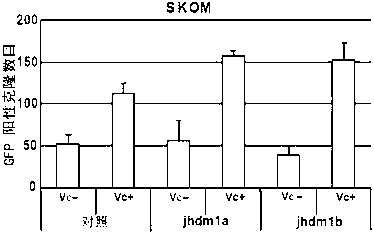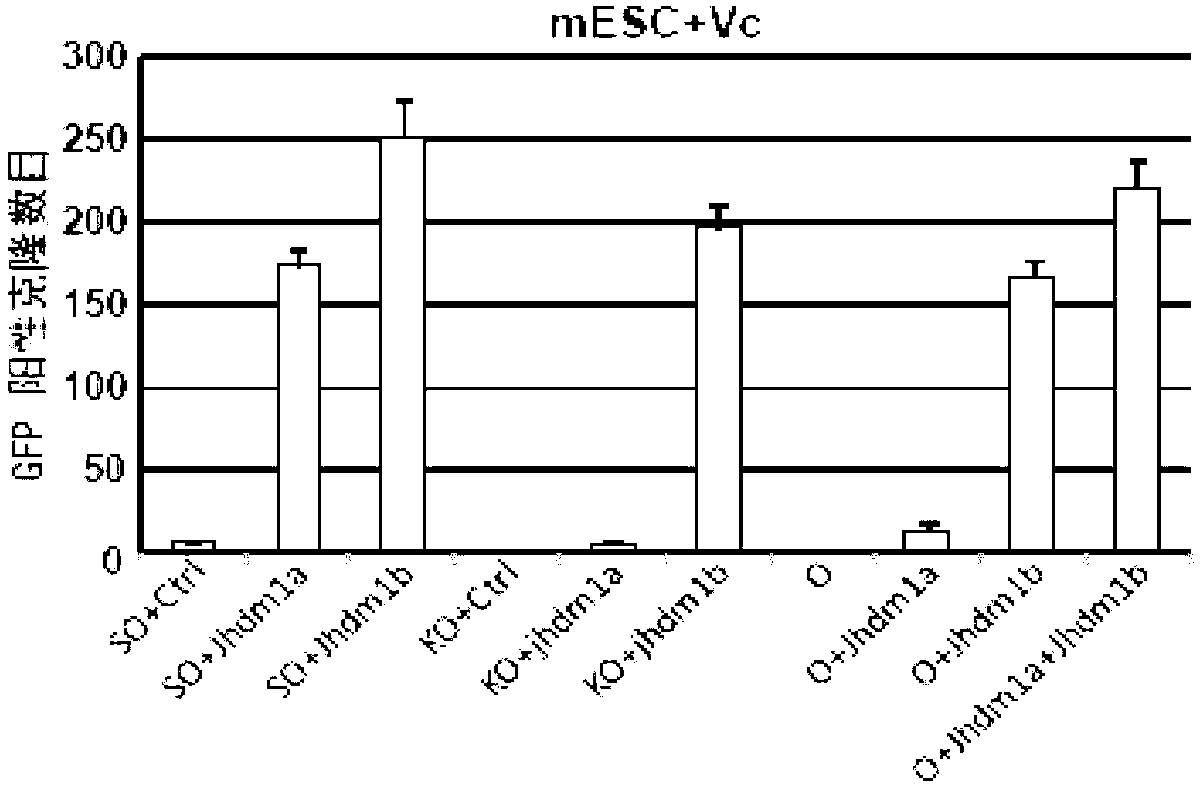Method for improving inductive generation efficiency of induced pluripotent stem cells
A technology for pluripotent stem cells and stem cells, which is applied in the field of improving the efficiency of inducing and generating pluripotent stem cells, can solve problems such as low induction efficiency, and achieve the effects of improving efficiency, improving quality and high induction efficiency.
- Summary
- Abstract
- Description
- Claims
- Application Information
AI Technical Summary
Problems solved by technology
Method used
Image
Examples
Embodiment 1
[0088] 1. Construction of vectors comprising Jhdm1a and Jhdm1b coding regions:
[0089] a. Cloning primer design
[0090] Sequence information for cDNA of Jhdm1a and Jhdm1b was obtained from http: / / www.ncbi.nlm.nih.gov / pubmed. The sequence of the Jhdm1a cDNA cloning region is SEQ ID NO: 1, the sequence of the Jhdm1b cDNA cloning region is SEQ ID NO: 2, and the coding sequences of Jhdm1a and Jhdm1b are amplified by designing specific primers.
[0091] The nucleotide sequence of the upstream primer of Jhdm1a is shown in SEQ ID NO: 3;
[0092] The nucleotide sequence of the downstream primer of Jhdm1a is shown in SEQ ID NO: 4;
[0093] The nucleotide sequence of the upstream primer of Jhdm1b is shown in SEQ ID NO: 5;
[0094] The nucleotide sequence of the downstream primer of Jhdm1b is shown in SEQ ID NO:6.
[0095] b. Amplification of coding sequences by RT-PCR
[0096] Total mRNA was extracted from isolated ICR mouse embryonic fibroblasts (MEFs) and human H1 embryonic ste...
Embodiment 1
[0130] Identification of induced pluripotent stem cells obtained in Example 1:
[0131] like image 3 as well as Figure 6 to Figure 10 As shown, a series of identification experiments were performed on Oct4 and Jhdm1b-induced pluripotent stem cell clones to prove whether they were iPS cells (induced pluripotent stem cells). Identification experiments included: quantitative PCR, immunofluorescence analysis of their surface markers, priming Sub-methylation level analysis, karyotype identification, chimera formation, etc.
[0132] Quantitative PCR experiment:
[0133] All quantitative PCR experiments were completed on the CFX-96 quantitative PCR instrument of Biorad Company using Takara’s kit, the reaction conditions used were 95°C for 2 minutes; 95°C for 10 seconds, 60°C for 30 seconds, read the fluorescence value, and repeat 40 loops.
[0134] Analysis of the methylation status of the promoter region
[0135] The analysis was determined by the sodium bisulfite sequencing ...
PUM
 Login to View More
Login to View More Abstract
Description
Claims
Application Information
 Login to View More
Login to View More - R&D
- Intellectual Property
- Life Sciences
- Materials
- Tech Scout
- Unparalleled Data Quality
- Higher Quality Content
- 60% Fewer Hallucinations
Browse by: Latest US Patents, China's latest patents, Technical Efficacy Thesaurus, Application Domain, Technology Topic, Popular Technical Reports.
© 2025 PatSnap. All rights reserved.Legal|Privacy policy|Modern Slavery Act Transparency Statement|Sitemap|About US| Contact US: help@patsnap.com



